A little keyword research can go a long, long way in improving your Search Engine Optimization (SEO) efforts and increasing your web traffic by helping you to provide Internet users with the answers and information they’re looking for online.
And that’s just the tip of the proverbial iceberg.
A good keyword research, if used effectively, forms the solid foundation upon which your entire blog content strategy is built. By gaining a clear understanding of the kind of things people want to know about, you put yourself in a good position to identify a profitable blog niche, come up with an extensive list of compelling blog post ideas that people actually want to read, and develop those posts in a way that gives readers exactly what they want.
In other words, if you want to start a successful blog in this day and age, keyword research is the most critical first step to take.
Still, just because you know, that doesn’t necessarily mean you know how to do it, and that’s why I put together this definitive guide to doing keyword research for SEO.
Having successfully built up a multi-million dollar content website portfolio, I’ve found that few of the things I’ve done have contributed more to my own success than researching keywords and making strategic decisions about how to use those keywords in my work.
Below, I’ll share with you the exact same process that I use to do research of my own. I’ll also answer all of your most burning questions so that you can leave here today armed with everything you need to know to get your own research underway.
What is Keyword Research?
In the most basic sense, keyword research is exactly what it sounds like:
It’s a process through which you discover the keywords and phrases that people put into search engines and then analyze your findings to discover which ones are worth targeting on your blog by telling you:
A). The search volume (number of times that term has been searched for) for each keyword. This helps to determine the popularity of that keyword so that you can decide whether it’s worth creating a blog post about it.
B). How difficult it is to rank for that keyword.
C). Any related keywords and phrases that you may also want to target.
Ultimately, this keyword research helps to create an informed, strategic approach to growing your blog.
It takes all of the guesswork out of knowing what to write about and how to write it, helps you to provide the answers and solutions that people are looking for online, and it helps you to do all this in a way that’s actually going to help you to achieve what you want to achieve with your blog.
If you don’t mind me going all meta for a moment, let’s take the example of using “how to do keyword research.”
Type that phrase into a keyword research service like the SEMRush Keyword Magic Tool, and you get all kinds of useful information.
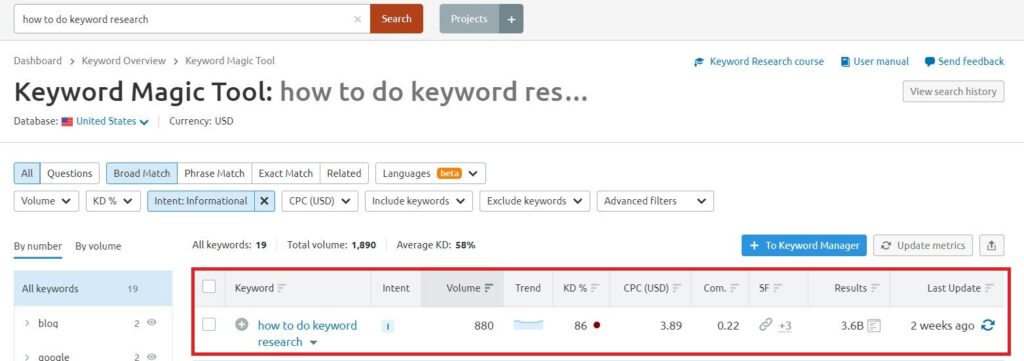
As you’ll see in the image above, you’ll learn not only the average number of monthly searches for “how to do keyword research” over the last year but also:
1. Search intent
In other words, the reasons why people are searching for this term. In this example, the intent is to find the answer to a question, and it’s that answer I’m aiming to provide with this post.
2. Trends
This relates to how popular a particular search term is now compared to in the past. In the example I’ve just used, the trend graph shows me that while there was a lull in the number of people who wanted to learn how to do keyword research for SEO, it’s back to almost the same level of popularity that it was at 12 months ago.
3. Keyword Difficulty
Expressed as a percentage, the Keyword Difficulty (KD) helps you to understand how hard it would be to organically rank in the top 10 Google search results for that keyword.
The higher the percentage, the more difficult it’s going to be to rank.
4. CPC Cost
This is the amount in US dollars that advertisers typically pay to display ads triggered by your chosen keyword.
As you can see, there’s a lot of incredibly valuable information here that is all going to help your SEO.
How to Do Keyword Research for SEO – A Step-by-Step Guide
So far, so good then, but how do you actually do keyword research for SEO?
How do you know which terms and phrases to add and analyze in the first place, and how do you make enough sense of the resulting data to actually be able to use it in a meaningful way?
I’ll show you how in the following simple eight-step process:
1. Brainstorm Your Initial Topic Ideas
First things first, you’ll need to come up with the broad, overarching subjects that you’ll want to focus on with your SEO content.
This is generally much easier if you already have a good idea of what your blog niche is going to be.
If you know that you want to write about health and fitness, for example, some topics that you might decide to focus on may include:
- Workout tips
- Exercise plans
- Health and fitness equipment reviews
- Diets and healthy eating
- Staying motivated and on course.
If you don’t know where to start with this, there are a few things you can do to help you identify those broad subject areas.
Think About Conversations You Have
Recall the last conversation you had with someone about your blog’s niche, or, better yet, the last couple of conversations.
What did you talk about?
What were the topics that kept coming to the fore?
What do people continually ask you about?
Remember, you’re looking at a broad overview here, so this doesn’t necessarily have to be specific things; you’re simply looking for those key themes that relate to your niche.
Sticking with the health and fitness niche, for example: if you spoke to one person about their interest in joining a Couch to 5K running program, another about their journey to starting at the gym for the first time, and a third person who hadn’t yet started to regularly workout but was looking into it, that might tell you that exercise for beginners might be a good topic to look into.
Use Google Suggestions

One of the easiest ways to generate more broad topic ideas is to simply head to Google and type your niche into Google and see what comes up in the suggestions.
This can prove even more useful as those suggestions are based on real user searches. It shows you the kind of themes and topics that people are searching for within your niche without getting too bogged down into specific details.
Think About Your Audience
Finally, it never hurts to spend a few moments considering your audience and what kind of subjects they’d be interested in reading more about.
To use a different example, let’s say you’re starting a marketing blog with the goal of establishing yourself as an expert in your field and, ultimately, selling consultation services.
You might think about the type of audience you want to attract and what kind of subjects would be most helpful to them, so you might decide that your broad subjects and themes include things like:
- Content marketing
- Marketing automation
- Social media marketing
- Search Engine Optimization
- Offline / traditional / print marketing
- Business to Business (B2B) marketing
- Business to Customer (B2C) marketing.
All of these general subjects can then be analyzed further to help you come up with the specific keywords you’d want to use in your content, and that’s where our next step comes in.
2. Consider Terms People Might Search For
With your list of subjects in place, your next step is to start thinking about the specific keywords and phrases that people might use when searching around that topic.
To use our marketing example, you might decide that you want to focus first and foremost on B2B marketing.
Here, the big question you’ll want to ask yourself is simply this:
What is it specifically that people would want to know about B2B marketing?
In answering that question, you might come up with a list of search terms such as:
- What is B2B marketing?
- B2B marketing automation
- The best free B2B marketing tools
- How to create a B2B content marketing strategy
- B2B marketing trends for 2022
- How to use social media for B2B marketing
- Effective B2B marketing case studies.
If you already have your blog up and running and are using Google Analytics, one easy way to help come up with this list of search terms would simply be to log into your account and go to Search Console – Queries as shown in the image below:

This will show you all of the recent search queries that people have typed into Google, which have ultimately led them to your website, meaning you’ve already got a good, solid list of ideas right off the bat.
If you don’t have Google Analytics set up or haven’t yet started your blog, another good way to come up with your list is simply to look around online at groups and forums.
Does Reddit have any popular subreddits related to your niche?
Are there Facebook groups?
Twitter hashtags?
Online networking groups?
If so, what kind of questions are being asked in those groups?
What are the hot topics of conversation right now?
What do people need help with?
Answering all of these questions will help you to further narrow down your broad topic themes into actual keywords.
Repeat this step for every theme or subject you came up with in step one before moving to the next step.
3. Chose a Keyword Research Tool
The good news is that you’re not alone out there when it comes to doing keyword research for SEO; there are a number of excellent tools out there to help you.
Some of my favorites include:
You can read all about why I like these particular services in my guide to the top 5 best keyword research tools to buy in 2022.
For the purposes of today’s guide, I’m going to focus on using SEMRush despite being the industry’s leading Search Engine Optimization tool for SEO professionals, and it’s still easy enough to use that even absolute novices will have no problem getting to grips with it in no time.
The platform also includes an extensive array of features that go above and beyond simple SEO keyword research, which is primarily why it’s my go-to service whenever I start planning to launch a new blog project or create content for my existing platforms.
If you’re serious about your SEO (and if you’ve read this far, I’m sure you are), then I recommend that you check out SEMrush for yourself. But, for now, let me show you how to sign up with this service and how to use it to determine which keywords are worth focussing your efforts on as you build and grow your blog.
How to Get Started With SemRush?

To begin, head to SEMRush.com and click the ‘Start Now’ button.

From there, create an account, either by logging in with your Google credentials or adding in an email and password.
If you choose the latter approach, you’ll need to check your email for a verification code that you can then enter into SEMRush; if you choose the former, you’ll save a few seconds as your email will already be validated.

Next, pick one of the platform’s premium plans to sign-up for and activate a free seven-day trial.
Personally, I recommend the Pro Plan as it’s the most cost-effective and provides more than enough tools, features, and resources for the average blogger.
A word to the wise, however, if you’re keeping a close eye on your budget, you can simply forget about all of this and use the Keyword Magic Tool for free.

Finally, enter your payment details, and after deciding whether to invite other team members to use SEMrush with you or not, you’re almost good to go.

Finally, on the next screen, you’ll be asked to choose your area of interest or, to put this another way, what you plan to use SEMRush for.
Although there are lots of great options here, I recommend clicking the ‘SEO’ button to dive into the keyword research tools.
With that done, you’re ready to start researching that initial list of keywords and phrases, identify which ones are worth pursuing further, and even come up with additional keywords you may not have previously thought of.
4. Look at Monthly Search Volumes for Each Keyword

Whether you use SEMRush or another tool entirely, one of your first tasks should be to look at the Monthly Search Volume (MSV) for each keyword.
This tells you the average amount of times that a particular keyword is entered into Google and helps you determine whether enough people search for that keyword to make it worth your while incorporating into your blog content.
To pick a random example, I went to the Keyword Overview tool on SemRush and entered the phrase “keyword research for bloggers.”
As you’ll see in the image above, this term only has an MSV of 30 here in the United States and doesn’t top more than 1.2K searches globally.
If I do this for each of the keywords that I created in step 2, I start to discover more popular keywords that I might want to focus on with my content, such as “keyword research for SEO,” which, at the time of writing, had an MSV of 1.3k in the US and 3.7K globally.
To sum this up, the higher the search volume number, the more popular that subject matter is, meaning there’s a much better chance that people will want to check out your content on this subject.
As you discover the search volumes for each keyword, you might find it a good idea to write them down (either as a straight list or in a spreadsheet) in order of popularity so that you’ve got a good idea of which subjects are likely to be your blog’s biggest hits.
5. Determine Ranking Difficulty
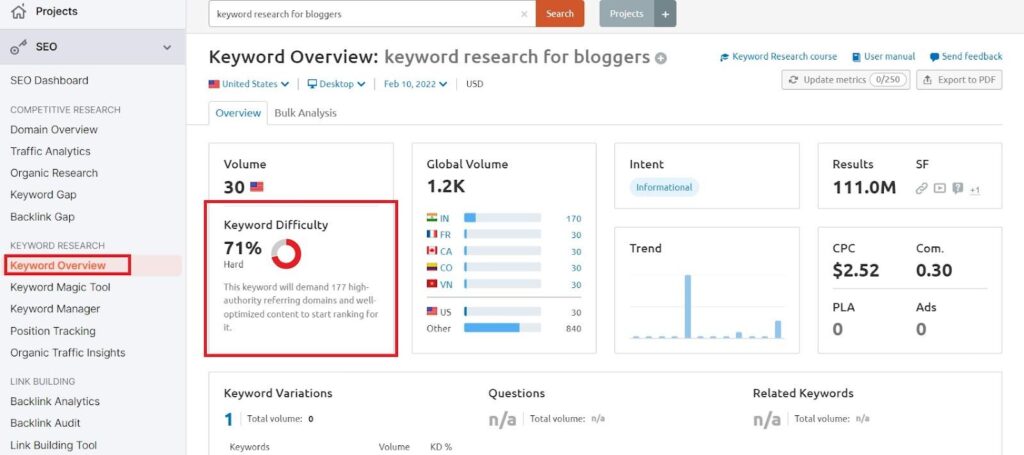
One of the many things I love about SEMRush is that it’s free and paid-for tools tell you how difficult it’s going to be to rank in the top ten organic search results for each keyword. And with 0% meaning it’s going to be super easy and 100% meaning it’s going to be almost impossible.
Paying attention to the keyword difficulty for each piece can help you to determine how much effort you’re going to need to put into each piece in order to rank for it.
That doesn’t mean that you shouldn’t give your very best effort in every post; of course, you should. It simply means that there may be some posts that you really have to go all out with and even some posts that you may decide not to bother with altogether.
Referring back to the ‘keyword research for bloggers’ example, even though it only has a relatively low search volume, I may have still considered incorporating that keyword into my blog. Well, 1.2k monthly searches are still 1.2k monthly searches, and I’d rather have those searches take people to my blog than somebody else’s.
However, when I look at the keyword difficulty, I notice that it’s at a pretty high 71%, meaning it’s going to be hard to rank well for that keyword without a great deal of backlinks from high-authority websites and extensively optimized content.
Sure, I might be willing to put that effort in if it was going to generate me more traffic, but do I really want to invest all that work for 1.2k global searches when I could put the same amount of effort in for a keyword that has twice or three times that amount?
The bottom line here is that you really want a mixture of both hard and easy to rank for keywords.
The keywords that are easy to rank for will prove ideal for getting those first sets of eyeballs on your content while you’re just starting out, whereas, if they’re done really, exceptionally well, the ones with a higher Keyword Difficulty ranking will ultimately help you to start to establish yourself as an authoritative voice in your niche and begin to increase your ability to complete in organic search results with those big, well-established brands in your niche.
6. Pay Attention to User Intent
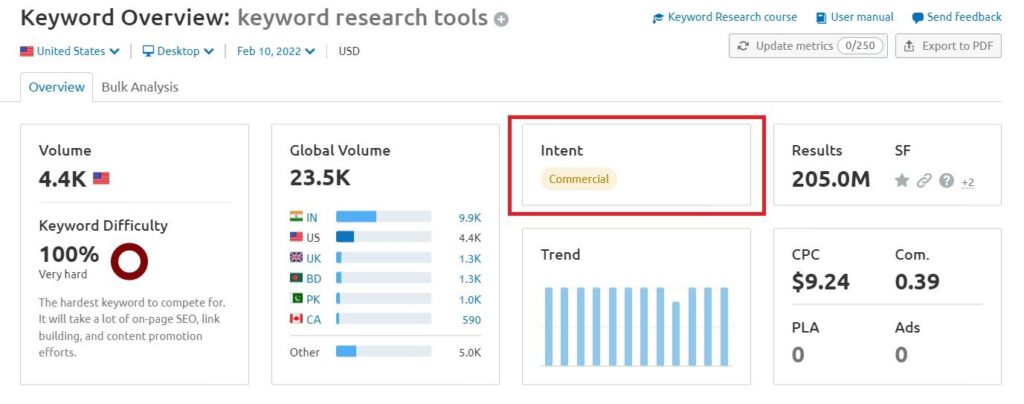
Whether you use SEMRush or a completely different platform, look for details about the user intent of each searched-for term, as this is going to help inform the kind of content you create for that term.
Using the term “keyword research tools,” for example, I see that the intent behind that search is commercial. That is, people are looking to investigate brands, products, or services, potentially with the view of later buying one.
Meanwhile, SEMRush tells me that the intent behind “keyword research for SEO” is informational. People are seeking out answers to specific questions, which, if you’re reading this right now, probably resonates with you.
You didn’t come here necessarily to find out about a product and buy it; you most likely came here to learn how to do keyword research, and, hopefully, I’ve done a pretty good job of teaching you so far.
Other common types of user intent include:
Navigational
People know precisely which website they want to visit, they just don’t necessarily know the web address of that site, or they do, but they’re searching for a specific topic on that site, such as by typing in:
ForrestWebber.com – keyword research.
Transactional
People have already done their commercial investigation. They know precisely what they want to buy and now they’re looking to buy it.
The more you understand about the user intent behind a keyword, the better you’ll be able to structure your content to give people what they want.
If a particular keyword is typically used for commercial investigation, that might mean that you do product/service reviews or “best of” round-ups like my guide to the top five email marketing services.
If it has an informational intent, you’re more likely to write how-tos, tutorials, or posts that simply provide answers to specific questions people have.
7. Investigate Keyword Variations
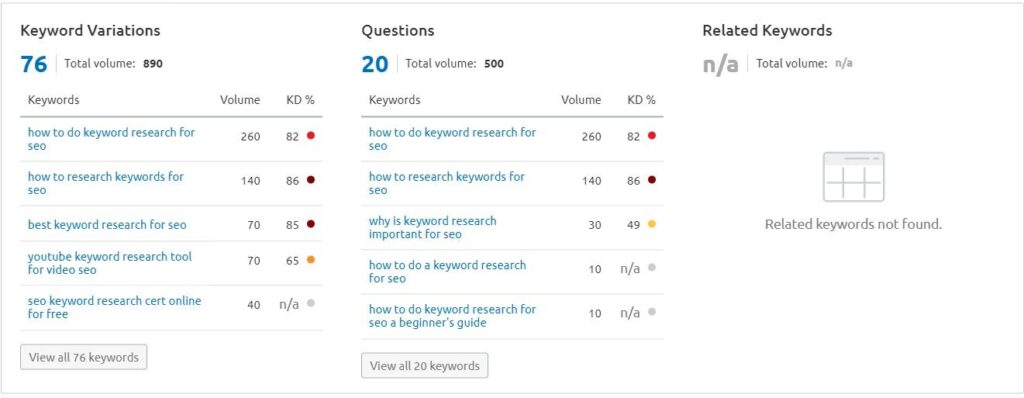
Finally, you’ll want to pay attention to the keyword variations, i.e., keywords and phrases that are similar to the ones you came up with and are based on the same topics but don’t use the exact same wording.
Going back once again to the example of “keyword research for SEO,” you’ll see that some keyword variations include:
- How to research keywords for SEO
- Best keyword research for SEO
- YouTube keyword research tool for YouTube SEO…
..And so on.
Using SEMRush, we can expand on that list by clicking “view all 76 keywords” to provide a more comprehensive list like this one:
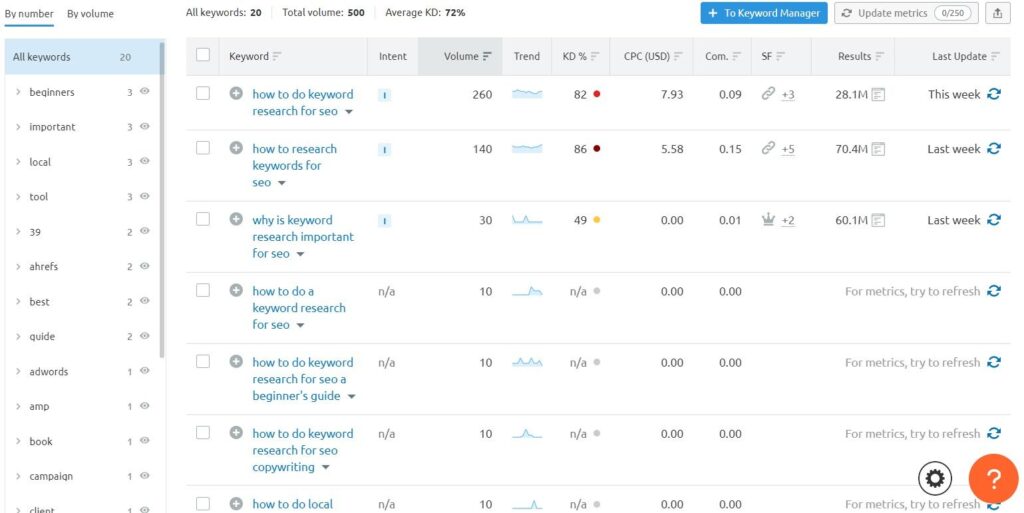
Here, you’ll see that each of these variations includes all of the essential data, including:
- Search Intent
- Monthly Search Volume
- Popularity (trend)
- Keyword Difficulty (KD) percentage
- Cost Per Click
- The number of search results generated for that keyword.
And more.
Going back a step, you’ll see that SEMRush also provides you with a list of specific questions that people type into search engines relating to your keyword.

Obviously, there’s going to be some overlap between the two here, but exploring the question-based search variations can prove very valuable in its own right in terms of coming up with blog post ideas for informational and tutorial-type content.
In fact, it’s largely for this reason that researching keyword variations proves to be such a worthwhile endeavor in the first place, as it will give you a great list of ideas that you may not have previously considered.
Searching for keyword variations can also help you determine if there’s a better approach to ranking for specific terms and phrases than the one you originally considered.
To put this another way, it may be that in the early stages of your keyword research, you came up with a keyword idea that you were sure was going to be super popular but which actually has a relatively low Monthly Search Volume. By looking at your variations, you may find that there’s a specific keyword that is much more popular but which will ultimately allow you to still write about the same subject.
8. Using Your Findings
Keyword research isn’t something you do just for the sake of doing it. It’s something you do as a stepping stone towards building a successful blog.
With that in mind, it’s now time to take your research and actually use it.
There are a few ways that you can do this, including:
- Create an extensive list of post titles that you can work on.
- Organize those post titles in order of priority, perhaps starting with those that have the largest monthly search volume and working your way down.
- Decide which keywords and keyword variations to pepper into those post titles in order to produce effective SEO results.
- Identify the best SEO keywords to use in your Pay Per Click (PPC) advertising and other marketing approaches.
However, you decide to use your keyword research, making it an unmissable step in your blogging journey will prove invaluable in helping you to achieve what most bloggers ultimately want to achieve:
Growing a blog platform by creating relevant content that people actually want to read.
Frequently Asked Questions About Keyword Research for SEO
Q1. How do I do SEO keyword research for free?
Ans. The SEMRush Keyword Magic Tool, Google Keyword Planner, and simply looking at the kind of content your competitors are creating are all great options for doing SEO keyword research.
Q2. How do you do keyword research like the SEO pros?
Ans. SEO pros will typically start with a broad list of subjects to write about, generate a list of potential keywords relating to those subjects, and then validate and refine their list with keyword research tools.
Q3. How many keywords should I use for SEO?
Ans. As a general rule, you’ll want to stick to one main keyword per blog post, though adding one or two keyword variations will also help boost the strength of those posts.
How to Do Keyword Research for SEO: A Final Piece of Advice
Though the guide above outlines just about everything you need to know to get your SEO keyword research journey underway, there’s just one final -and very important- thing I need to tell you:
This isn’t a one-and-done deal.
In other words, just because you spend time doing keyword research today doesn’t mean you’ll never have to do it again.
Things change. Your blog may change. Your audience’s interests will certainly change -or at least evolve- over time and, as a consequence, so too will the kind of things they search for on Google.
That means that while the keyword research you did today might stand you in good stead, for now, three or four months down the line, there may be a few different queries with a high search volume that you’ll want to capitalize on before your competitors do.
It’s for this reason that the final piece of advice that I leave you with today is simply this:
Repeat this process on a regular and consistent basis.
OK, so you don’t have to do this research every week or even every month, but as a rule of good practice, try and get in the habit of repeating the eight steps above at least once a quarter.
Even if very little has changed, checking in a few times a year will undoubtedly give you the confidence to know that you’re on the right track and are doing everything you need to be doing to help ensure the long-term success of your blog.

